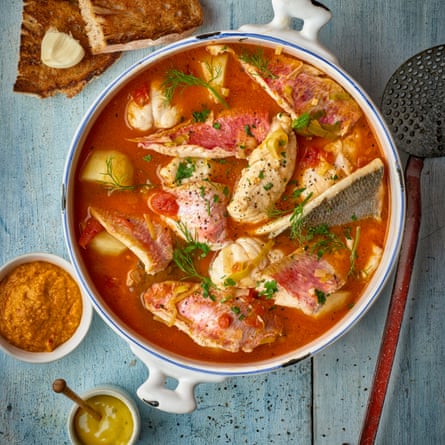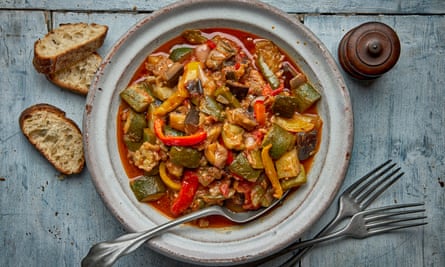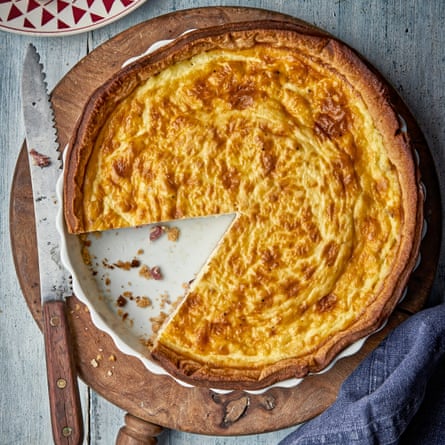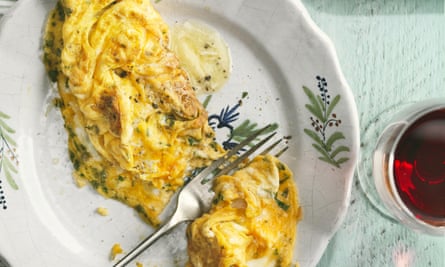The Roux brothers’ moules au cidre du pays d’auge (mussels in cider)
Albert adores this simple and delicious dish, especially when the sauce is made with slightly sour Normandy cream. For Michel, the great delight is to drink a medium dry cider with the mussels.
Serves 4
butter 120g
shallots 3, finely chopped
medium dry cider 400ml
thyme 1 sprig
bay leaf 1
double cream 200ml
mussels 1kg, preferably bouchot, scrubbed, debearded and well washed
salt and freshly ground pepper
chives 1 tbsp, snipped, to serve
Melt 40g butter in a large saucepan. Put in the shallots and sweat for 1-2 minutes, then add 300ml cider, the thyme and bay leaf. Reduce the cider by about one-third, then add the cream and mussels and cover the pan.
Raise the heat to very high and cook for 3-4 minutes, shaking the pan every minute, so that the mussels at the bottom rise to the top. When the mussels have opened, tip them and their juices into a colander set over a bowl.
Pour the juices into a saucepan and reduce to a light juice. Add the remaining cider, bring to the boil, then swirl in the rest of the butter by shaking the pan or using a wire whisk. Season with salt and pepper.
Pour the mussels into a soup tureen or china salad bowl. Discard the thyme, bay leaf and any mussels which have not opened. Pour two-thirds of the sauce over the mussels, sprinkle with chives and serve the rest of the sauce separately. Do not delay before tucking into the mussels; they must be eaten piping hot.
For a more attractive presentation, leave the mussels on the half shell. Place 25 or 30 mussels in individual deep plates and pour over the hot sauce.
From French Country Cooking by The Roux Brothers (Quadrille Publishing, £25). To order a copy for £21.25, go to bookshop.theguardian.com or call 0330 333 6846. Free UK p&p over £10, online orders only. Phone orders min. p&p of £1.99.
Claudia Roden’s bouillabaisse

The people of Marseilles do not accept that it is possible to make a real bouillabaisse outside of the Riviera, and they consider it presumptuous that anybody should even try. One reason given is that the spiny scorpion fish rascasse, which gives a unique aroma to the broth and is said to be the soul of bouillabaisse, is not available. But there are so many other flavours which come into play and with the Mediterranean fish now obtainable at many fishmongers you should be able to do very well even without rascasse. Anyway, as it is often difficult to find rascasse on the Riviera now and as there are so many versions of what real bouillabaisse should be, it is not right that the Marseillais should keep the monopoly.
Bouillabaisse is a meal in itself, or rather two courses – a soup and a separate fish dish. It is worth making for a large number because you need a good variety of fish. Make a selection from the following which are available here, many from British waters: moray or conger eel, red mullet, gurnard, a small monkfish tail, small bream, small bass, John Dory. If you are near the Mediterranean, get rascasse and other small rockfish. You can also choose to make a sumptuous bouillabaisse with spiny lobsters and king prawns.
Once the fish is cleaned, gutted and scaled and the ingredients are assembled, it is quick and easy to make.
Serves 10-12
olive oil 125ml
onions 2 large, chopped
leeks 2, finely chopped
garlic 5 cloves, crushed
ripe tomatoes 500g, peeled and chopped
thyme a sprig
bay leaves 2
fennel a sprig of the fronds
dried orange peel a 5cm piece
boiling water or fish stock 3 litres
salt and pepper
saffron ¼ tsp
fish 2.75kg
To serve
French bread 10-12 slices, toasted and (optional) rubbed with garlic
parsley a bunch, finely chopped
a bowl of aioli (see below)
a bowl of rouille (see below)
For the aioli
garlic 8-15 cloves, pounded or crushed to a paste
egg yolks 3
salt
olive oil 600ml
lemons juice of 1-2 (optional)
For the traditional rouille of Provence
white bread 3-4 slices, crusts removed
garlic 4 cloves, crushed
red chilli pepper ½-1, de-seeded and chopped, or 1 tsp paprika and a good pinch of cayenne
saffron pistils a good pinch, crushed with a spoon
olive oil 5 tbsp
Heat 4 tablespoons of oil in a large pan. Fry the onions and leeks till golden, then add the garlic and when the aroma rises add the tomatoes and cook 5 minutes. Add the thyme, bay, fennel and orange peel. Pour in the boiling water or stock, beating vigorously, and raise the heat to high. Season with salt and pepper, add the rest of the oil and continue to boil vigorously for a few minutes so that the oil is properly mixed and does not float, then add the saffron. Reduce the heat and put in the fish and simmer for 5-8 minutes.
Lift each fish out carefully as soon as it becomes cooked and arrange on a serving dish. Reserve a little stock for the rouille. Leave one or two of the softer-fleshed fish in for a longer time so that they disintegrate, giving body to the soup. The total cooking time should be 15 minutes maximum. Keep the fish warm. Pour or strain the broth straight into a serving bowl or over pieces of toasted garlic bread placed in individual plates. Sprinkle with chopped parsley. Serve accompanied by aiolli and rouille and hot boiled potatoes.
To make the aioli, all the ingredients must be at room temperature. Put the garlic in a large, warmed bowl. Add the yolks and a little salt and beat for a minute until the paste is thick and sticky.
Pour in the oil, drop by drop, beating with a wooden spoon or a whisk. When the sauce thickens, which it should do by the time ⅓ of the oil has been added, you can pour the oil in a thin trickle but keep beating all the time and make sure that it is being properly absorbed. When about ½ the oil has been incorporated add a little lemon juice or a tablespoon of warm water, then continue beating in the oil until the aïoli is very thick. Add the rest of the lemon juice to taste.
If the sauce is too solid or there is a risk of it curdling, 1 or 2 tablespoons of warm water will help. If the oil is added too quickly, the aioli may separate, but you can easily save it by starting again with a fresh yolk in a new bowl and slowly beating in the separated sauce.
You can also make the sauce in a food processor. Blend the garlic and yolks with the salt, then add the oil in a thin stream while the blades are running. Add lemon juice, then taste and adjust the seasonings.
To make the rouille, blend the bread with the rest of the ingredients and add enough of the reserved fish stock to make a light cream.
From Mediterranean Cookery by Claudia Roden
Richard Olney’s ratatouille

The smoky note from the peppers grilled over wood embers is unique to Lulu’s ratatouille. The vegetables are precooked, separately, each in a different way, before being assembled, simmered together, and reduced to a melting perfection in which some are dispersed and absorbed into the whole while others retain their identity. Ratatouille can be served hot as an accompaniment to roast or grilled meats and it is delicious incorporated into scrambled eggs.
Lulu usually serves it at room temperature as a vegetable course on its own. As a variation, she recommends stirring in, at the last minute, a handful of pitted black olives and the diced crisp heart of a head of celery.
Serves 6
olive oil about 165ml
large sweet onions 450g, split in two and finely sliced
salt
garlic 6 cloves, lightly crushed, peeled and finely sliced
courgette 450g, quartered lengthwise and cut into 2cm sections
firm young aubergine 450g, unpeeled, cut into 2cm cubes
tomatoes 450g, peeled, seeded and quartered
large sweet peppers 1 red, 1 yellow, 1 green, grilled, peeled, seeded and cut lengthwise into narrow strips, juices reserved
bouquet garni containing 2 bay leaves and 2 or 3 thyme sprigs
pepper
Warm 3 tablespoons olive oil in a wide, heavy 9-11 litre pot, add the onions, and cook, covered, over very low heat, stirring occasionally with a wooden spoon, for at least 30 minutes, or until they are melting and simmering in their own juices but uncoloured.
Remove the lid, raise the heat slightly, and cook, stirring regularly, until they are uniformly light golden brown. Add the salt, garlic and courgette, and continue to stir regularly.
Meanwhile, heat 4 tablespoons olive oil in a large frying pan and add the aubergine and salt. Saute, tossing and turning until the pieces are softened. Add them to the pot with the onions and courgette, reserving any remaining oil in the frying pan.
Add more oil to the frying pan if it is nearly dry. Over high heat, add the tomatoes and salt; saute, shaking the pan and tossing constantly until their liquid has evaporated. Remove them from the heat before they begin to disintegrate and empty the frying pan into the pot.
Add the peppers and their juices to the pot, immerse the bouquet garni, and adjust the heat to maintain a simmer, pot uncovered, for about 2 hours. Displace the vegetables gently, scraping the bottom and sides of the pot with the wooden spoon from time to time and lowering the heat as the liquid reduces, until all excess liquid has evaporated and the vegetables are coated in a syrupy sauce. Remove from the heat, grind over pepper, and taste for salt. If prepared ahead, transfer to a dish and leave to cool before covering and refrigerating – the flavours will ripen over a day or two. If meant to be served at room temperature (too cold, the flavours are paralysed), remove the ratatouille from the refrigerator an hour or so before serving and stir in a couple of tablespoons of olive oil at the last minute.
From Lulu’s Provencal Table by Richard Olney
Simon Hopkinson’s quiche lorraine

Pedant that I am, it had always annoyed me that, when fashioning a lovely quiche Lorraine, the little chunks of bacon always sank to the bottom of the pastry case while the quiche cooked. As I have always preferred a deepish enclosure to the custard filling, this irritating scenario soon became tiresome, and needed solving. And why was it that the same quiche in a fine Parisian pâtisserie had nicely golden bits of bacon poking up out of its eggy surface, and mine did not? Well, the trick is to use the thinnest bacon slices rather than, say lardons (so readily available now, ready cut, I know) and cut them into small slivers. These will then float to the surface, but also nicely suspend themselves throughout the mixture as it sets. Result, as they say.
Serves 4
For the pastry
butter 60g
lard 60g
plain flour 200g
salt a pinch
ice-cold water 2-3 tbsp
For the filling
smoked streaky bacon 10-12 thin rashers, cut into slivers
egg yolks 4
whole eggs 3
whipping cream 400ml
a little salt and much freshly ground white pepper
nutmeg a generous scraping
To make the pastry, cut the butter and lard into small chunks and place in a large bowl with the flour and salt. Gently rub the fat into the flour using fingertips until the texture resembles very coarse breadcrumbs. Mix in only just enough water to bind the mixture together. Lightly knead this dough until well amalgamated, dust with flour and slip into a plastic bag. Place in the fridge for 30 minutes before using.
Preheat the oven to 180C/gas mark 4 and also place a flat baking sheet in there, which will help to cook the base of the quiche more evenly.
Roll out the pastry as thinly as possible, use to line a 20cm wide by 4cm deep tart tin, lightly prick the base with a fork all over, then bake blind. This is done by lining the uncooked pastry case with a sheet of kitchen foil and filling with some dried haricot beans, for instance. It is then cooked for about 15-20 minutes on the flat baking sheet, removed from the oven, and the foil and beans transferred to a container for future use. Return the pastry case to the oven for a further 10 minutes or so, until it is pale golden, crisp and well cooked through, particularly the base.
Lightly fry the bacon in a dry, non-stick frying pan for a minute or two, until crisp and some of the fat has run out. Drain on kitchen paper and spread out evenly over the base of the cooked tart case. Whisk the egg yolks and whole eggs together, stir in the cream and season with salt, pepper and nutmeg. Pour the custard into the pastry case and cook for 30-40 minutes, or until nicely puffed and the surface of the custard is pale golden and just set. Eat warm, or at room temperature. Hot quiche, straight from the oven, does not taste good; it will, in fact, be tasteless.
From The Good Cook by Simon Hopkinson
Claudia Roden’s pissaladiere (onion tart)

This famous onion tart of Nice derives its name from the anchovy paste, pissala, which used to be brushed on it. Now the traditional anchovy garnish is more often absent while the thick onion filling has become even thicker. You may find the larger quantity of onion given in the recipe excessive but this is the way the Niçois (and I) prefer it.
Serves 6
For the dough
plain flour 250g
egg 1, beaten
salt ¾ tsp
fresh yeast 15g, or 1½ tsp dried yeast
sugar ¼ tsp
warm water 75ml
olive oil a few drops
For the filling
onions 1-2kg, thinly sliced
olive oil 3-4 tbsp
salt and pepper
mixed fresh herbs, such as basil, thyme and rosemary 2 tsp, chopped
anchovy fillets 12 or more
black olives a few, stoned and halved
To make the bread dough, sift the flour into a bowl and make a well in the centre. Put the beaten egg and salt in the well. Put the yeast, sugar and water in a bowl and leave it until froths. Then gradually stir the yeast mixture into the flour, mixing it in with your fingers to form a ball of soft dough. Add a little flour if it is too sticky and knead well with your hands for 10 minutes or until the dough is smooth and elastic. Pour a drop or two of olive oil on the dough and turn it in your hands so that it becomes lightly oiled all over. Cover with a damp cloth and leave to rise in a warm place for an hour or until it doubles in bulk.
While the dough is rising make the filling. Cook the onions in the olive oil in a covered pan on a very low flame, stirring occasionally, for 40 minutes or until they are very soft. Add the salt, pepper and herbs and continue to cook for a few minutes longer. Cut the anchovy fillets in half lengthways.
Preheat the oven to 190C/gas mark 5. Grease a pie plate or flan dish about 35cm in diameter with oil. Punch the dough down, knead it lightly and press it into the the pie pan with the palms of your hands. Spread the onion mixture over the dough and make a lattice pattern of anchovy fillets on top. Put half an olive in the middle of each square. Let the dough rise again for 10-15 minutes, then bake for 25-30 minutes or until the bread base is cooked. Serve hot.
From Mediterranean Cookery by Claudia Roden
Elizabeth David’s omelette fines herbes

As everybody knows, there is only one infallible recipe for the perfect omelette: your own. Reasonably enough; a successful dish is often achieved by quite different methods from those advocated in the cookery books or by the professional chefs, but over this question of omelette-making, professional and amateur cooks alike are particularly unyielding. Argument has never been known to convert anybody to a different method, so if you have your own, stick to it and let others go their cranky ways, mistaken, stubborn and ignorant to the end.
It is therefore to anyone still in the experimental stage that I submit the few following points which I fancy are often responsible for failure when that ancient iron omelette pan, for twenty years untouched by water, is brought out of the cupboard.
First, the eggs are very often beaten too savagely. In fact, they should not really be beaten at all, but stirred, and a few firm turns with two forks do the trick. Secondly, the simplicity and freshness evoked by the delicious word “omelette” will be achieved only if it is remembered that it is the eggs which are the essential part of the dish: the filling, being of secondary importance, should be in very small proportion to the eggs. Lying lightly in the centre of the finished omelette, rather than bursting exuberantly out of the seams, it should supply the second of two different tastes and textures; the pure egg and cooked butter taste of the outside and ends of the omelette, then the soft, slightly runny interior, with its second flavouring of cheese or ham, mushrooms or fresh herbs.
As far as the pan is concerned, a 10-inch omelette pan will make an omelette of 3 or 4 eggs. Beat them only immediately before you make the omelette, lightly as described above, with two forks, adding a light mild seasoning of salt and pepper. Allow about ½oz [15g] of butter. Warm your pan, don’t make it red hot. Then turn the burner as high as it will go. Put in the butter and when it has melted and is on the point of turning colour, pour in the eggs. Add the filling, and see that it is well embedded in the eggs. Tip the pan towards you and with a fork or spatula gather up a little of the mixture from the far side. Now tip the pan away from you so that the unset eggs run into the space you have made for them.
When a little of the unset part remains on the surface the omelette is done. Fold it in three with your fork or palette knife, hold the pan at an angle and slip the omelette out on to the waiting dish. This should be warmed, but only a little, or the omelette will go on cooking. An omelette is nothing to make a fuss about. The chief mistakes are putting in too much of the filling and making this too elaborate. Such rich things as foie gras or lobster in cream sauce are inappropriate. Moderation in every aspect is the best advice where omelettes are concerned. Sauces and other trimmings are superfluous, a little extra butter melted in the warm omelette dish or placed on top of the omelette as you serve it being the only addition which is not out of place.
Prepare 1 tablespoon of mixed finely chopped parsley, tarragon, chives and, if possible, chervil. Mix half of this, with salt and pepper, in the bowl with the eggs, and the other half when the eggs are in the pan. If you like, put a little knob of butter on top of the omelette as it is brought to the table.
From French Provincial Cooking by Elizabeth David (Grub Street, £15.99). To order a copy for £12.74, go to bookshop.theguardian.com or call 0330 333 6846. Free UK p&p over £10, online orders only. Phone orders min. p&p of £1.99.







Comments (…)
Sign in or create your Guardian account to join the discussion